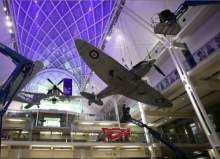
From fighter jets to battle tanks and artillery, the Imperial War Museum’s atrium display has thrilled children and adults alike since the Lambeth site opened in 1936.
For now the exhibition space is limited as the museum undergoes a dramatic makeover before its grand re-opening in 2014, to mark the centenary of the First World War.
One of the most exciting new exhibition pieces that will be unveiled next year is an RAF Harrier jump jet which served as recently as the Afghanistan conflict.
The vertical take-off aircraft is enjoying a well-earned retirement from military service having served since the 1960s. The last one flew from an aircraft carrier in 2010, and the following year the remaining aircraft were sold to the US Marine Corps for parts.
But one second-generation Harrier remains in the UK. Harrier GR9 ZD461 was grounded after suffering a brake fire during an exercise in 2010, and is currently undergoing conservation at the Imperial War Museum in Duxford.
So what makes this particular model special? It was originally deployed to Germany and has served in Iraq and Afghanistan, before being deployed aboard HMS Invincible in 2005. It will be the first aircraft displayed at the Imperial War Museum with Afghanistan service history.
We take a special look at the aircraft at its temporary home in Duxford, and speak to conservation Manager Chris Knapp about what makes it as iconic as its historical forbears.
Berenice Baker: In your opinion, what makes the Harrier iconic?
Chris Knapp: Everyone loves the Harrier. It was the first vertical take-off aircraft; it’s been used at sea, it’s been used on land, the US Marine Corps use it very effectively. It’s just the aircraft everyone recognises. From a personal point of view, my father was involved with Rolls-Royce developing the engines and nozzles.
BB: What are you doing to make the new Harrier display-ready?
CK: We are inspecting it to check it’s structurally sound, suitable for suspension in London, inhibiting where necessary to make sure we don’t get any corrosion and making sure we’ve got a good system to suspend it from.
BB: Would that include objects that arrive in war-torn condition?
CK: Oh yes, because that’s the history of the object. My job is to preserve history, so damage to an object may well be what makes it significant, or the fact that an object is not particularly effective or efficient makes it significant because troops still had to use them.
BB: What is the difference between conservation and restoration?
CK: Conservation is preserving the original. Restoration would really be strip down, totally rebuild, improve and repair.
We don’t go down that route; we try to conserve as much as possible.
We are in the business of conserving history, not turning out nice, shiny airplanes or vehicles.
Sometimes we have to go down the restoration route; if we do we are very fussy about originality, correct colours and getting it as accurate as possible.
BB: When did the Harrier arrive here?
CK: About 18 months ago. RAF Joint Aircraft Recovery & Transportation Squadron (JARTS) brought it in for us in a couple of trucks. The wing had been removed for road transport and all the hard points and pylons were removed. The guys brought it in, unloaded it and assembled it for us, so we can move it into our hangar here and do the work we needed to do.
BB: What damage did the Harrier sustain?
CK: The aircraft suffered a brake fire during an exercise in Nevada and was trucked over America then brought home by sea. The RAF declared it as Category 5 [a write-off] at the time, but they’ve since repaired the aircraft. Really all we had to do when it reached Duxford was repair the paint damage, and one of two skin fasteners had been left out. Other than that it was sound.
BB: What stage is the conservation at now?
CK: It’s effectively complete. We fortunately had very little to do; the object was in good condition when it arrived. We’ve just done some inhibiting, we’ve put in a false engine because we didn’t get an engine with the aircraft and we had to dress it to look right on display. It’s being prepared for transport down to out London branch at the beginning of September, with the wing following in November.
BB: What have been the key stages for the conservation so far?
CK: The main priority has been inspecting the aircraft to ensure it’s suitable for suspension, and designing a suspension system for display in the atrium. We break it down into four sections.
We go to a certified stress engineer / designer who will design the system and give me a set of working drawings to take to the manufacturer.
My staff will then install them and we inspect them here, then we go to a contractor who will physically [place] them up into the roof space.
BB: This aircraft served as recently as Afghanistan. Is it the newest artefact you’ve worked on?
CK: I think it is. One of the oldest we have is an 1890s steam engine from an ornithopter [flapping winged aircraft].
Follow Berenice Baker on Google+
Related content
Military models strut on Paris Air Show runway
Home-grown talent was very much the order of the day at this year’s Paris Air Show at Le Bourget, with European defence suppliers showcasing aircraft, helicopters, UAVs, payloads and missile defence systems.
Hypersonic MUSTARD and the piggy-back Fighter Jet: BAE’s forgotten aircraft
Over the years BAE Systems has produced many of the most iconic and game changing defence technologies but not all have made it past the drawing board.


.gif)

